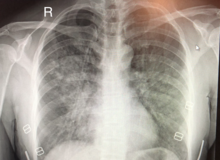User:Mr. Ibrahem/High-altitude pulmonary edema
| High-altitude pulmonary edema | |
|---|---|
| Other names | High-altitude pulmonary oedema (HAPO)[1] |
 | |
| Chest x-ray of HAPE showing characteristic patchy alveolar infiltrates with right middle lobe predominance. | |
| Specialty | Emergency medicine, wilderness medicine |
| Symptoms | Shortness of breath, bluish colored skin, cough[2] |
| Usual onset | 2 to 5 days[2] |
| Causes | Altitude > 2,500 meters (8,200 ft)[2] |
| Diagnostic method | Based on symptoms[2] |
| Differential diagnosis | Asthma, acute bronchitis, pneumonia, heart attack[2] |
| Treatment | Immediate descend, oxygen, nifedipine, portable hyperbaric chamber[2] |
| Frequency | At 4,500 meters (15,000 ft) ~3%[2] |
High-altitude pulmonary edema (HAPE) is a type of altitude illness were fluid builds up in the lungs.[2] Early symptoms may include tiredness, shortness or breath with exercise, and dry cough.[2] This may worsen to shortness of breath at rest, pink tinged cough, and bluish colored skin.[2] Onset is generally after being at altitude for 2 to 5 days.[2] About 15% of cases are complicated by high altitude cerebral edema.[2]
It mostly occur due to altitudes above 2,500 meters (8,200 ft) but may occur as low as 2,000 meters (6,600 ft).[2] Risk factors include genetics, rapid ascent, strenuous exercise, pulmonary hypertension, and a high salt diet.[2] The underlying mechanism is believed to involve constriction of blood vessels in the lungs as a response to low oxygen.[2] It is a type of noncardiogenic pulmonary edema.[2] Diagnosis is based on symptoms.[2]
Treatment is by immediate descend to a lower altitude.[2] If descending is not possible oxygen, nifedipine, or a portable hyperbaric chamber may be used.[2] At 4,500 meters (15,000 ft) about 0.6 to 6% of people are affected.[2] Males are more commonly affected than females.[2] Severe cases may have a risk of death of up to 50% without treatment.[2]
References[edit]
- ^ Oelz, O; Maggiorini, M; Ritter, M; Waber, U; Jenni, R; Vock, P; Bärtsch, P (25 November 1989). "Nifedipine for high altitude pulmonary oedema". Lancet. 2 (8674): 1241–4. doi:10.1016/s0140-6736(89)91851-5. PMID 2573760. S2CID 30715338.
- ^ a b c d e f g h i j k l m n o p q r s t u v Jensen, JD; Vincent, AL (January 2020). "High Altitude Pulmonary Edema". PMID 28613569.
{{cite journal}}: Cite journal requires|journal=(help)
